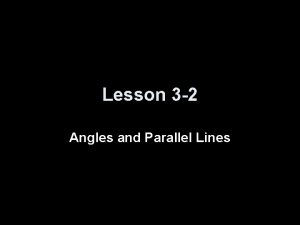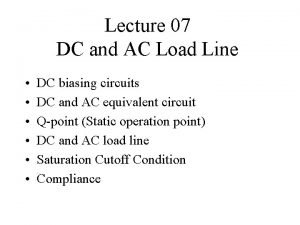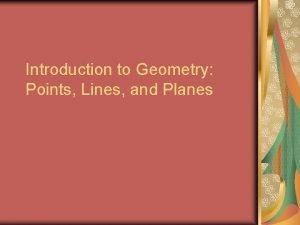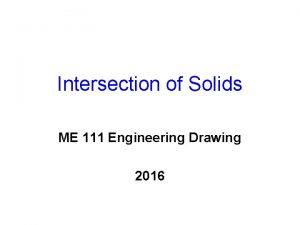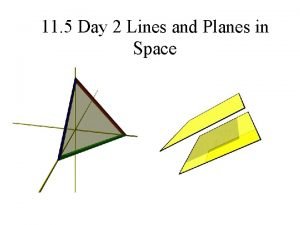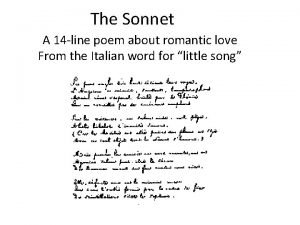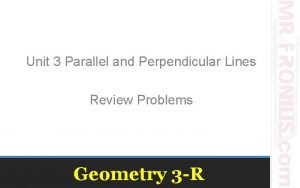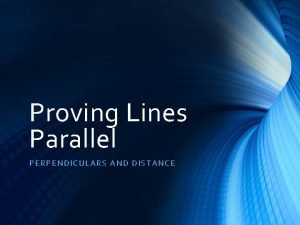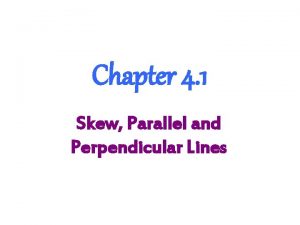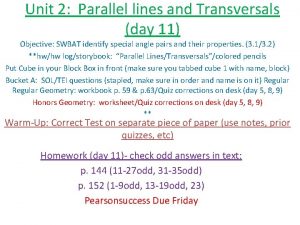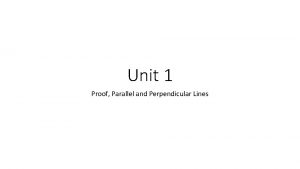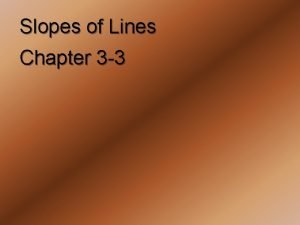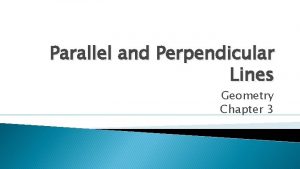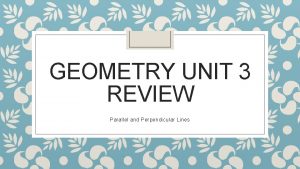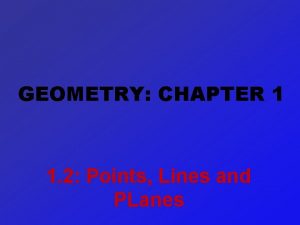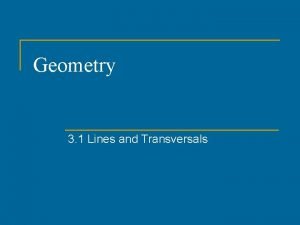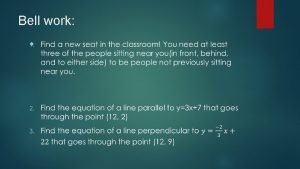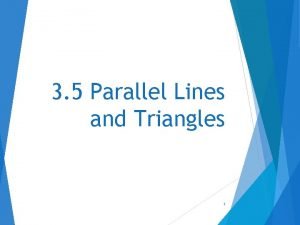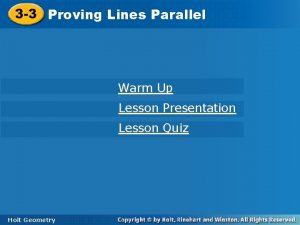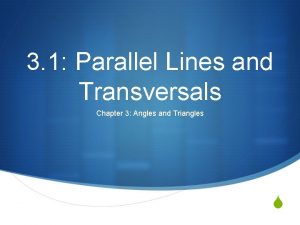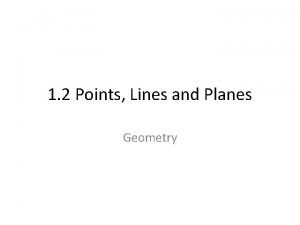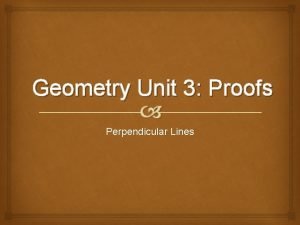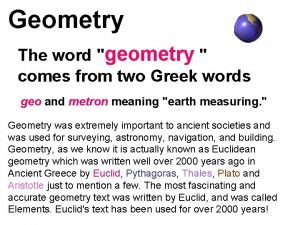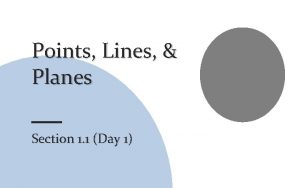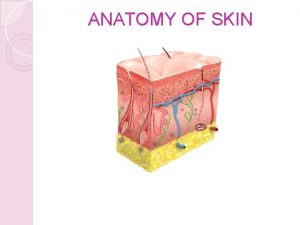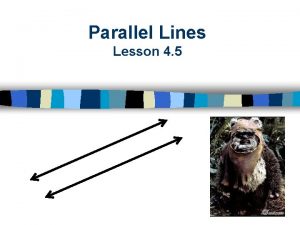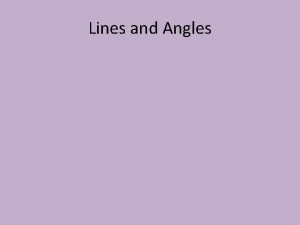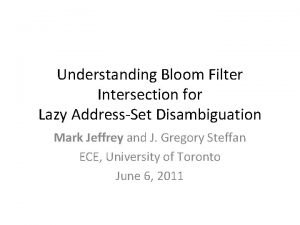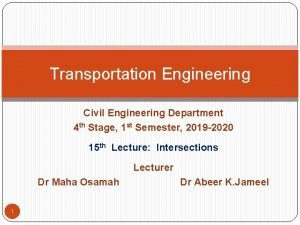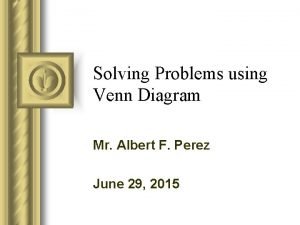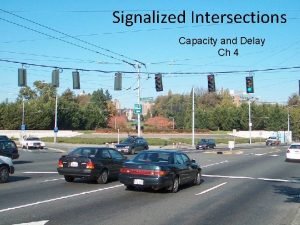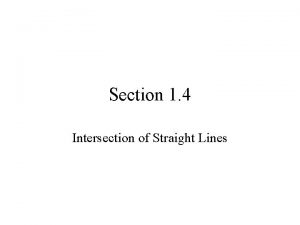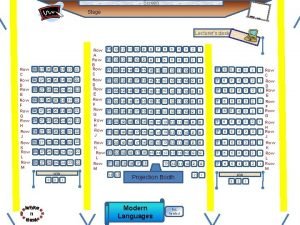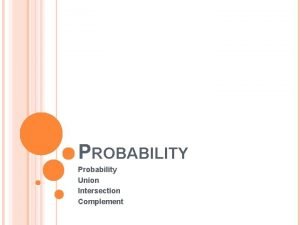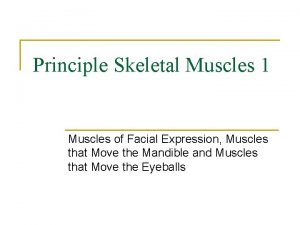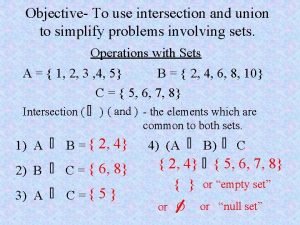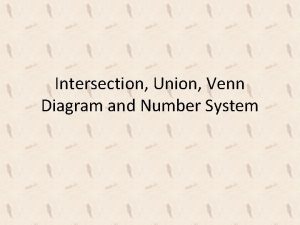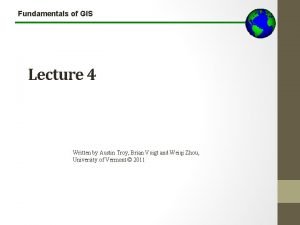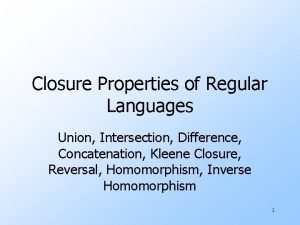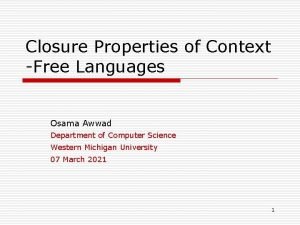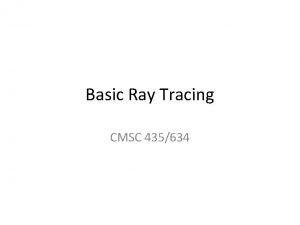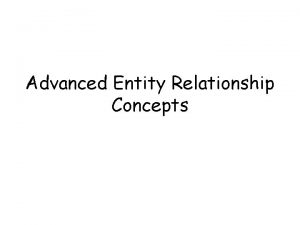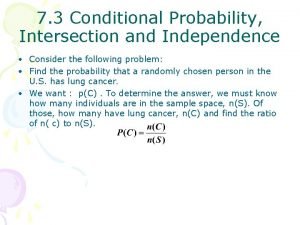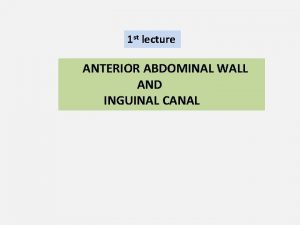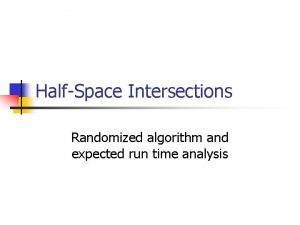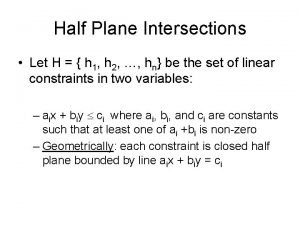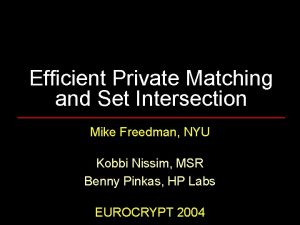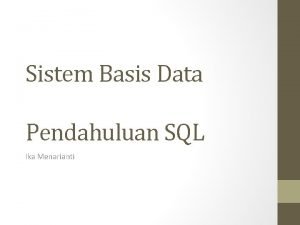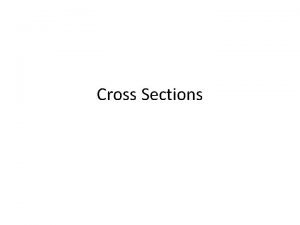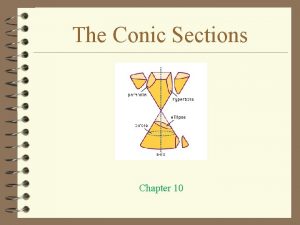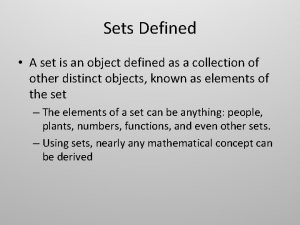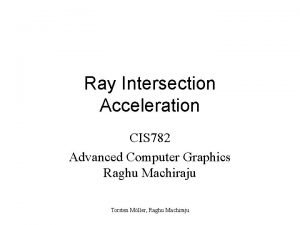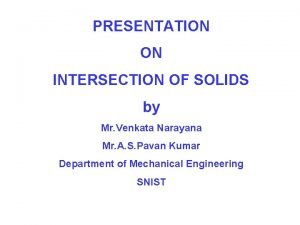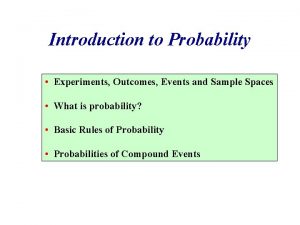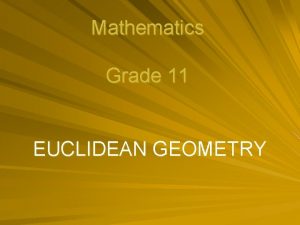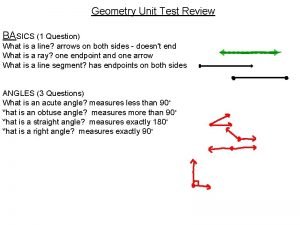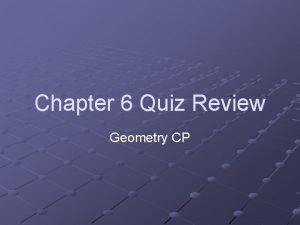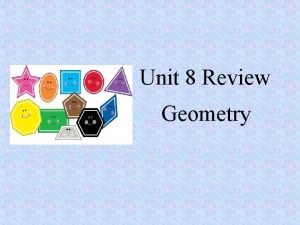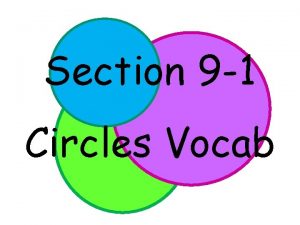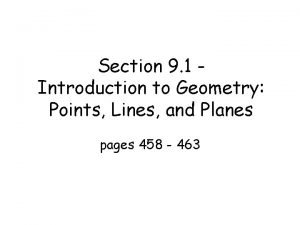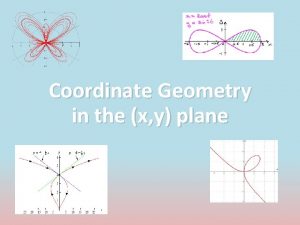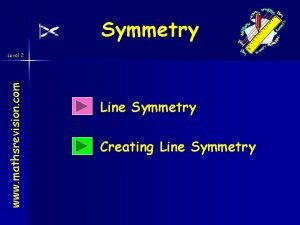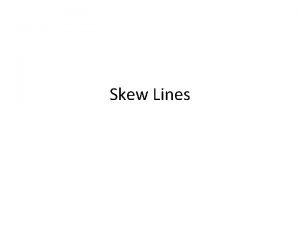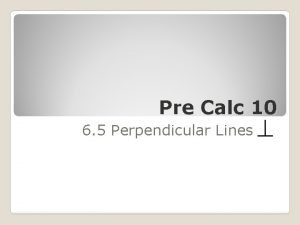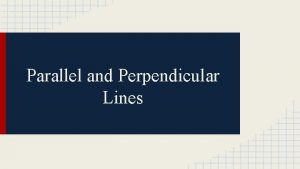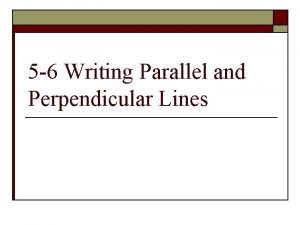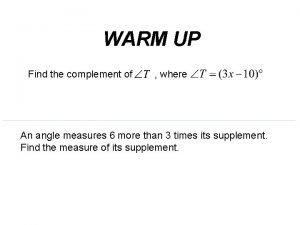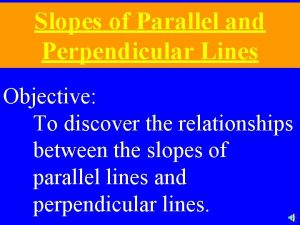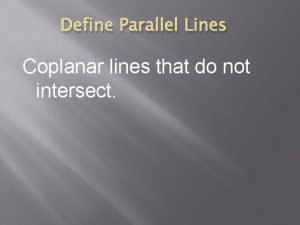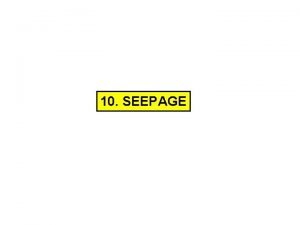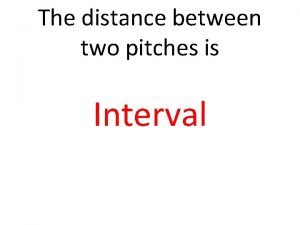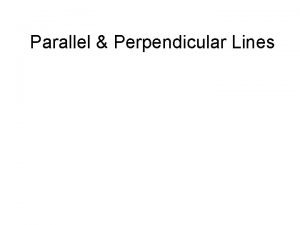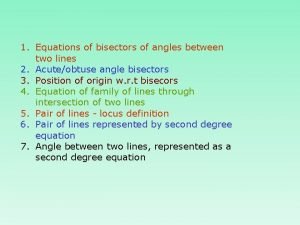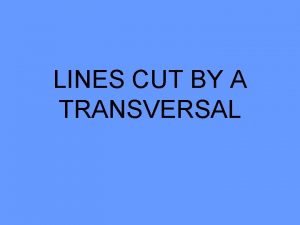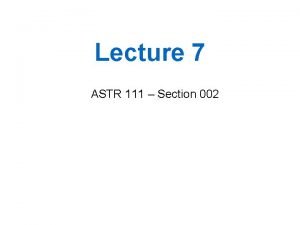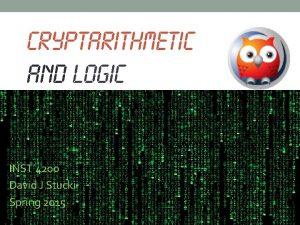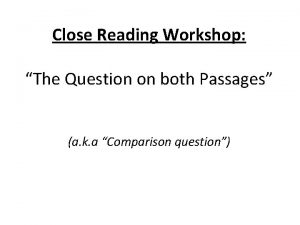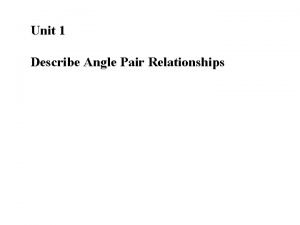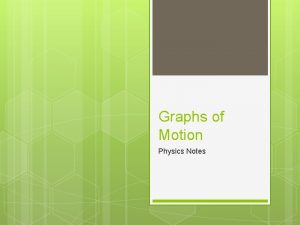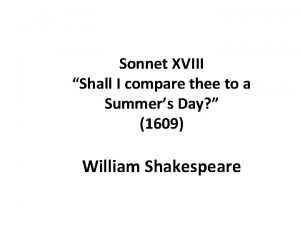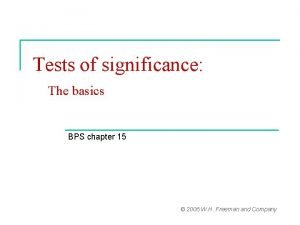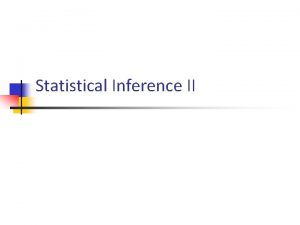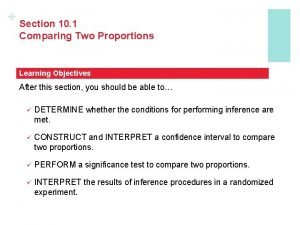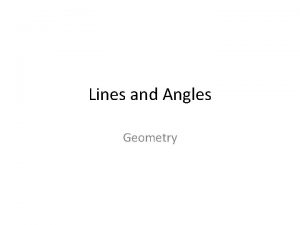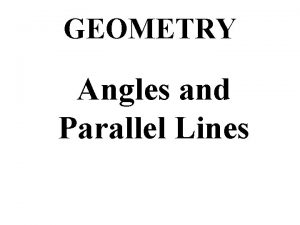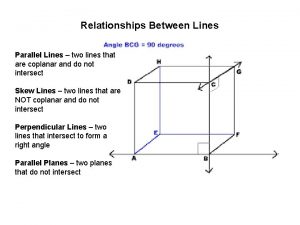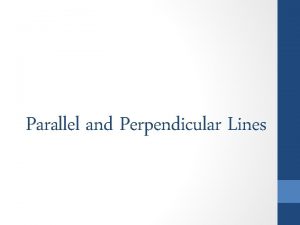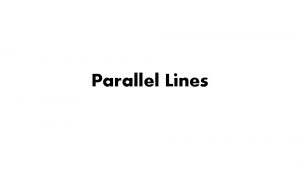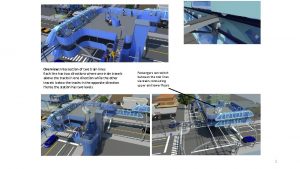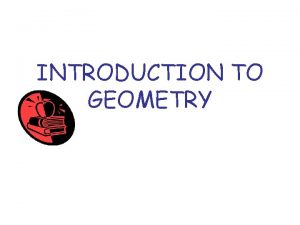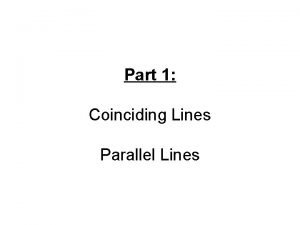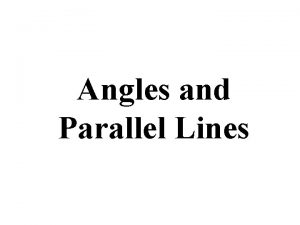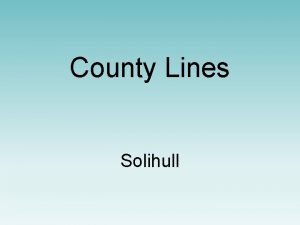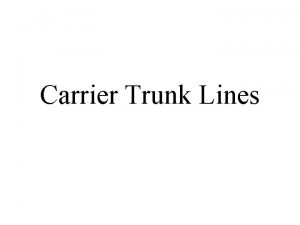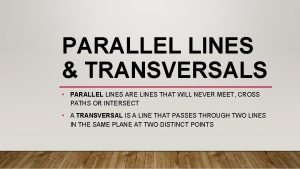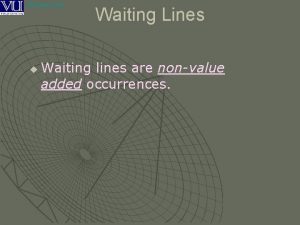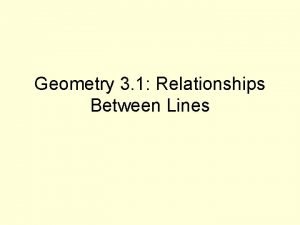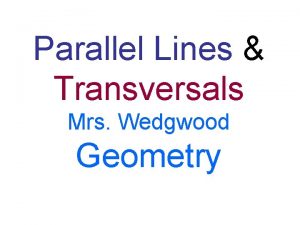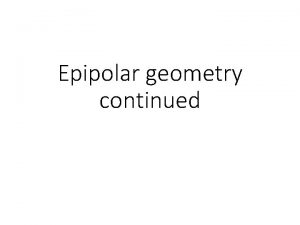Geometry Introduction Topic Introduction Two lines Intersection Test
























































































































































- Slides: 152

Geometry Introduction

Topic • • • Introduction Two lines Intersection Test Point inside polygon Convex hull Line Segments Intersection Algorithm

Geometry Components • Scalar (S) • Point (P) • Free vector (V) Allowed operations • S*V V • V+V V • P–P V • P+V P

Examples u+v Vector addition v u p Point subtraction p-q q p+v v Point-vector addition p


Euclidean Geometry • In affine geometry, angle and distance are not defined. • Euclidean geometry is an extension providing an additional operation called “inner product” • There are other types of geometry that extends affine geometry such as projective geometry, hyperbolic geometry…

Dot product is a mapping from two vectors to a real number. Dot product Length Distance Angle Orthogonality: u and v are orthogonal when

Topic • • • Introduction Two lines Intersection Test Point inside polygon Convex hull Line Segments Intersection Algorithm

Cross-Product-Based Geometric Primitives Some fundamental geometric questions: source: 91. 503 textbook Cormen et al. p 3 p 2 p 3 (1) p 4 p 2 p 1 p 0 p 2 p 1 (2) (3)

Cross-Product-Based Geometric Primitives: (1) p 2 33. 1 p 0 (1) Advantage: less sensitive to accumulated round-off error source: 91. 503 textbook Cormen et al.

Cross-Product-Based Geometric Primitives: (2) p 2 p 1 33. 2 p 0 (2) source: 91. 503 textbook Cormen et al.

is. Left() // is. Left(): tests if a point is Left|On|Right of an infinite line. // Input: three points P 0, P 1, and P 2 // Return: >0 for P 2 left of the line through P 0 and P 1 // =0 for P 2 on the line // <0 for P 2 right of the line int is. Left( Point P 0, Point P 1, Point P 2 ) { return ( (P 1. x - P 0. x) * (P 2. y - P 0. y) - (P 2. x - P 0. x) * (P 1. y - P 0. y) ); }

Segment-Segment Intersection • Finding the actual intersection point • Approach: parametric vs. slope/intercept – parametric generalizes to more complex intersections • e. g. segment/triangle • Parameterize each segment Lcd Lab c Lcd c C=d-c b a Lab b q(t)=c+t. C A=b-a d d a p(s)=a+s. A Intersection: values of s, t such that p(s) =q(t) : a+s. A=c+t. C 2 equations in unknowns s, t : 1 for x, 1 for y source: O’Rourke, Computational Geometry in C

Assume that a = (x 1, y 1) b = (x 2, y 2) c = (x 3, y 3) d = (x 4, y 4)

Code typedef struct point { double x; double y; } point; typedef struct line { point p 1; point p 2; } line; int check_lines(line *line 1, line *line 2, point *hitp) { double d = (line 2 ->p 2. y - line 2 ->p 1. y)*(line 1 ->p 2. x-line 1 ->p 1. x) (line 2 ->p 2. x - line 2 ->p 1. x)*(line 1 ->p 2. y-line 1 ->p 1. y); double ns = (line 2 ->p 2. x - line 2 ->p 1. x)*(line 1 ->p 1. y-line 2 ->p 1. y) - (line 2 ->p 2. y - line 2 ->p 1. y)*(line 1 ->p 1. x-line 2 ->p 1. x); double nt = (line 1 ->p 2. x - line 1 ->p 1. x)*(line 1 ->p 1. y - line 2 ->p 1. y) (line 1 ->p 2. y - line 1 ->p 1. y)*(line 1 ->p 1. x - line 2 ->p 1. x); if(d == 0) return 0; double s= ns/d; double t = nt/d; return (s >=0 && s <= 1 && t >= 0 && t <= 1)); }

Intersection of 2 Line Segments Step 1: Bounding Box Test p 3 and p 4 on opposite sides of p 1 p 2 p 4 p 1 (3) Step 2: Does each segment straddle the line containing the other? 33. 3 source: 91. 503 textbook Cormen et al.

Topic • • • Introduction Two lines Intersection Test Point inside polygon Convex hull Line Segments Intersection Algorithm

Point Inside Polygon Test • Given a point, determine if it lies inside a polygon or not

Ray Test • Fire ray from point • Count intersections – Odd = inside polygon – Even = outside polygon

Problems With Rays • Fire ray from point • Count intersections – Odd = inside polygon – Even = outside polygon • Problems – Ray through vertex

Problems With Rays • Fire ray from point • Count intersections – Odd = inside polygon – Even = outside polygon • Problems – Ray through vertex

Problems With Rays • Fire ray from point • Count intersections – Odd = inside polygon – Even = outside polygon • Problems – Ray through vertex – Ray parallel to edge

Solution • Edge Crossing Rule – an upward edge includes its starting endpoint, and excludes its final endpoint; – a downward edge excludes its starting endpoint, and includes its final endpoint; – horizontal edges are excluded; and – the edge-ray intersection point must be strictly right of the point P. • Use horizontal ray for simplicity in computation

Code // cn_Pn. Poly(): crossing number test for a point in a polygon // Input: P = a point, // V[] = vertex points of a polygon V[n+1] with V[n]=V[0] // Return: 0 = outside, 1 = inside // This code is patterned after [Franklin, 2000] int cn_Pn. Poly( Point P, Point* V, int n ) { int cn = 0; // the crossing number counter // loop through all edges of the polygon for (int i=0; i<n; i++) { // edge from V[i] to V[i+1] if (((V[i]. y <= P. y) && (V[i+1]. y > P. y)) // an upward crossing || ((V[i]. y > P. y) && (V[i+1]. y <= P. y))) { // a downward crossing // compute the actual edge-ray intersect x-coordinate float vt = (float)(P. y - V[i]. y) / (V[i+1]. y - V[i]. y); if (P. x < V[i]. x + vt * (V[i+1]. x - V[i]. x)) // P. x < intersect ++cn; // a valid crossing of y=P. y right of P. x } } return (cn&1); // 0 if even (out), and 1 if odd (in) }

A Better Way

A Better Way

A Better Way

A Better Way

A Better Way

A Better Way

A Better Way

A Better Way

A Better Way

A Better Way

A Better Way

A Better Way • One winding = inside

A Better Way

A Better Way

A Better Way

A Better Way

A Better Way

A Better Way

A Better Way

A Better Way

A Better Way

A Better Way

A Better Way

A Better Way • zero winding = outside

Requirements • Oriented edges • Edges can be processed in any order

Advantages • Extends to 3 D! • Numerically stable • Even works on models with holes: – Odd k: inside – Even k: outside • No ray casting

Actual Implementation

Winding Number Int wn_Pn. Poly( Point P, Point* V, int n ) { int wn = 0; // the winding number counter // loop through all edges of the polygon for (int i=0; i<n; i++) { // edge from V[i] to V[i+1] if (V[i]. y <= P. y) { // start y <= P. y if (V[i+1]. y > P. y) // an upward crossing if (is. Left( V[i], V[i+1], P) > 0) // P left of edge ++wn; // have a valid up intersect } else { // start y > P. y (no test needed) if (V[i+1]. y <= P. y) // a downward crossing if (is. Left( V[i], V[i+1], P) < 0) // P right of edge --wn; // have a valid down intersect } } return wn; }

Topic • • • Introduction Two lines Intersection Test Point inside polygon Convex hull Line Segments Intersection Algorithm

Convex Hulls p p pq q Subset of S of the plane is convex, if for all pairs p, q in S the line segment pq is completely contained in S. The Convex Hull CH(S) is the smallest convex set, which contains S.

Convex hull of a set of points in the plane Rubber band experiment • • • The convex hull of a set P of points is the unique convex polygon whose vertices are points of P and which contains all points from P.

Convexity & Convex Hulls source: O’Rourke, Computational Geometry in C • A convex combination of points x 1, . . . , xk is a sum of the form a 1 x 1+. . . + akxk where • Convex hull of a set of points is the set of all convex combinations of points in the set. source: 91. 503 textbook Cormen et al. nonconvex polygon convex hull of a point set

Convex Hull • Input: – Set S = {s 1, …, sn} of n points • Output: – Find its convex hull • Many algorithms: – – – Naïve – O(n 3) Insertion – O(n logn) Divide and Conquer – O(n logn) Gift Wrapping – O(nh), h = no of points on the hull Graham Scan – O(n logn)

Naive Algorithms for Extreme Points Algorithm: INTERIOR POINTS for each i do for each j = i do for each k = j = i do for each L = k = j = i do if p. L in triangle(pi, pj, pk) then p. L is nonextreme O(n 4) Algorithm: EXTREME EDGES for each i do for each j = i do for each k = j = i do if pk is not left or on (pi, pj) then (pi , pj) is not extreme O(n 3) source: O’Rourke, Computational Geometry in C

Algorithms: 2 D Gift Wrapping • Use one extreme edge as an anchor finding the next q Algorithm: GIFT WRAPPING i 0 index of the lowest point i i 0 repeat for each j = i Compute counterclockwise angle q from previous hull edge k index of point with smallest q Output (pi , pk) as a hull edge i k O(n 2) until i = i 0 source: O’Rourke, Computational Geometry in C

Gift Wrapping source: 91. 503 textbook Cormen et al. 33. 9 Output Sensitivity: O(n 2) run-time is actually O(nh) where h is the number of vertices of the convex hull.

Algorithms: 3 D Gift Wrapping O(n 2) time [output sensitive: O(n. F) for F faces on hull] Cx. Hull Animations: http: //www. cse. unsw. edu. au/~lambert/java/3 d/hull. html

Algorithms: 2 D Quick. Hull • Concentrate on points close to hull boundary • Named for similarity to Quicksort a b A c finds one of upper or lower hull Algorithm: QUICK HULL function Quick. Hull(a, b, S) if S = 0 return() else c index of point with max distance from ab A points strictly right of (a, c) B points strictly right of (c, b) return Quick. Hull(a, c, A) + (c) + Quick. Hull(c, b, B) O(n 2) source: O’Rourke, Computational Geometry in C

Algorithms: 3 D Quick. Hull Cx. Hull Animations: http: //www. cse. unsw. edu. au/~lambert/java/3 d/hull. html

Algorithms: >= 2 D Convex Hull boundary is intersection of hyperplanes, so worst-case combinatorial size (not necessarily running time) Qhull: http: //www. qhull. org/ complexity is in:

Graham’s Algorithm source: O’Rourke, Computational Geometry in C • Points sorted angularly provide “star-shaped” starting point • Prevent “dents” as you go via convexity testing q p 0

Graham Scan • Polar sort the points around a point inside the hull • Scan points in counter-clockwise (CCW) order – Discard any point that causes a clockwise (CW) turn • If CCW, advance • If !CCW, discard current point and back up

Graham Scan source: 91. 503 textbook Cormen et al.

Graham-Scan : (1/11) p 10 p 11 p 12 p 9 p 7 p 8 p 6 p 5 p 3 p 4 p 2 p 1 p 0

Graham-Scan : (1/11) p 10 p 11 p 12 p 9 p 7 p 8 p 6 p 5 p 3 p 4 p 2 p 1 p 0 1. Calculate polar angle 2. Sorted by polar angle

Graham-Scan : (2/11) p 10 p 11 p 12 p 9 p 7 p 8 p 6 Stack S: p 2 p 1 p 0 p 5 p 3 p 4 p 2 p 1 p 0

Graham-Scan : (3/11) p 10 p 11 p 12 p 9 p 7 p 8 p 6 Stack S: p 3 p 1 p 0 p 5 p 3 p 4 p 2 p 1 p 0

Graham-Scan : (4/11) p 10 p 11 p 12 p 9 p 7 p 8 p 6 p 4 Stack S: p 3 p 1 p 0 p 5 p 3 p 4 p 2 p 1 p 0

Graham-Scan (5/11) p 10 p 11 p 12 p 9 p 7 p 8 p 5 Stack S: p 3 p 1 p 0 p 5 p 6 p 4 p 3 p 2 p 1 p 0

Graham-Scan (6/11) p 10 p 11 p 12 p 9 p 7 p 8 p 6 p 4 p 8 p 7 p 6 p 5 Stack S: p 3 p 1 p 0 p 5 p 3 p 2 p 1 p 0

Graham-Scan (7/11) p 9 p 6 p 5 Stack S: p 3 p 1 p 0 p 5 p 10 p 11 p 12 p 6 p 9 p 8 p 7 p 4 p 3 p 2 p 1 p 0

Graham-Scan (8/11) p 10 p 11 p 12 p 10 Stack S: p 3 p 1 p 0 p 9 p 8 p 7 p 6 p 5 p 4 p 3 p 2 p 1 p 0

Graham-Scan (9/11) p 10 p 11 p 12 p 11 p 10 Stack S: p 3 p 1 p 0 p 9 p 8 p 7 p 6 p 5 p 4 p 3 p 2 p 1 p 0

Graham-Scan (10/11) p 10 p 12 p 11 p 12 p 10 Stack S: p 3 p 1 p 0 p 9 p 8 p 7 p 6 p 5 p 4 p 3 p 2 p 1 p 0

Time complexity Analysis • Graham-Scan – Sorting in step 2 needs O(n log n). – Time complexity of stack operation is O(2 n) – The overall time complexity in Graham-Scan is O(n log n). • Demo: – http: //www. cse. unsw. edu. au/~lambert/java/3 d/hull. html

Graham Scan source: 91. 503 textbook Cormen et al.

Graham Scan source: 91. 503 textbook Cormen et al.

Algorithms: 2 D Incremental source: O’Rourke, Computational Geometry in C • Add points, one at a time – update hull for each new point • Key step becomes adding a single point to an existing hull. – Find 2 tangents • Results of 2 consecutive LEFT tests differ • Idea can be extended to 3 D. Algorithm: INCREMENTAL ALGORITHM Let H 2 Convex. Hull{p 0 , p 1 , p 2 } for k 3 to n - 1 do Hk Convex. Hull{ Hk-1 U pk } O(n 2) can be improved to O(nlgn)

Algorithms: 3 D Incremental O(n 2) time Cx. Hull Animations: http: //www. cse. unsw. edu. au/~lambert/java/3 d/hull. html

Algorithms: 2 Dsource: Divide-and-Conquer O’Rourke, Computational Geometry in C • Divide-and-Conquer in a geometric setting • O(n) merge step is the challenge – Find upper and lower tangents – Lower tangent: find rightmost pt of A & leftmost pt of B; then “walk it downwards” B A • Idea can be extended to 3 D. Algorithm: DIVIDE-and-CONQUER Sort points by x coordinate Divide points into 2 sets A and B: A contains left n/2 points B contains right n/2 points Compute Convex. Hull(A) and Convex. Hull(B) recursively Merge Convex. Hull(A) and Convex. Hull(B) O(nlgn)

Convex Hull – Divide & Conquer • Split set into two, compute convex hull of both, combine.

Convex Hull – Divide & Conquer • Split set into two, compute convex hull of both, combine.

Convex Hull – Divide & Conquer • Split set into two, compute convex hull of both, combine.

Convex Hull – Divide & Conquer • Split set into two, compute convex hull of both, combine.

Convex Hull – Divide & Conquer • Split set into two, compute convex hull of both, combine.

Convex Hull – Divide & Conquer • Split set into two, compute convex hull of both, combine.

Convex Hull – Divide & Conquer • Split set into two, compute convex hull of both, combine.

Convex Hull – Divide & Conquer • Split set into two, compute convex hull of both, combine.

Convex Hull – Divide & Conquer • Split set into two, compute convex hull of both, combine.

Convex Hull – Divide & Conquer • Split set into two, compute convex hull of both, combine.

Convex Hull – Divide & Conquer • Split set into two, compute convex hull of both, combine.

Convex Hull – Divide & Conquer • Merging two convex hulls.

Convex Hull – Divide & Conquer • Merging two convex hulls: (i) Find the lower tangent.

Convex Hull – Divide & Conquer • Merging two convex hulls: (i) Find the lower tangent.

Convex Hull – Divide & Conquer • Merging two convex hulls: (i) Find the lower tangent.

Convex Hull – Divide & Conquer • Merging two convex hulls: (i) Find the lower tangent.

Convex Hull – Divide & Conquer • Merging two convex hulls: (i) Find the lower tangent.

Convex Hull – Divide & Conquer • Merging two convex hulls: (i) Find the lower tangent.

Convex Hull – Divide & Conquer • Merging two convex hulls: (i) Find the lower tangent.

Convex Hull – Divide & Conquer • Merging two convex hulls: (i) Find the lower tangent.

Convex Hull – Divide & Conquer • Merging two convex hulls: (i) Find the lower tangent.

Convex Hull – Divide & Conquer • Merging two convex hulls: (ii) Find the upper tangent.

Convex Hull – Divide & Conquer • Merging two convex hulls: (ii) Find the upper tangent.

Convex Hull – Divide & Conquer • Merging two convex hulls: (ii) Find the upper tangent.

Convex Hull – Divide & Conquer • Merging two convex hulls: (ii) Find the upper tangent.

Convex Hull – Divide & Conquer • Merging two convex hulls: (ii) Find the upper tangent.

Convex Hull – Divide & Conquer • Merging two convex hulls: (ii) Find the upper tangent.

Convex Hull – Divide & Conquer • Merging two convex hulls: (ii) Find the upper tangent.

Convex Hull – Divide & Conquer • Merging two convex hulls: (iii) Eliminate non-hull edges.

Algorithms: 3 D Divide and Conquer O(n log n) time ! Cx. Hull Animations: http: //www. cse. unsw. edu. au/~lambert/java/3 d/hull. html

Topic • • • Introduction Two lines Intersection Test Point inside polygon Convex hull Line Segments Intersection Algorithm

Line segment intersection • Input: – Set S = {s 1, …, sn} of n line segments, si = (xi, yi) • Output: – k = All intersection points among the segments in S

Line segment intersection • Worst case: – k = n(n – 1)/2 = O(n 2) intersections • Sweep line algorithm (near optimal algorithm): – O(n log n + k) time and O(n) space – O(n) space

Sweep Line Algorithm Avoid testing pairs of segments that are far apart. Idea: imagine a vertical sweep line passes through the given set of line segments, from left to right. Sweep line

Assumption on Non-degeneracy No segment is vertical. // the sweep line always hits a segment at // a point. If a segment is vertical, imagine we rotate it clockwise by a tiny angle. This means: For each vertical segment, we will consider its lower endpoint before upper point.

Sweep Line Status The set of segments intersecting the sweep line. It changes as the sweep line moves, but not continuously. Updates of status happen only at event points. left endpoints right endpoints intersections A G C T event points

Ordering Segments A total order over the segments that intersect the current position of the sweep line: • Based on which parts of the segments we are B>C>D currently interested in (A and E not in the ordering) B A E C D C>D (B drops out of the ordering) D>C (C and D swap their positions) At an event point, the sequence of segments changes: Update the status. Detect the intersections.

Status Update (1) Event point is the left endpoint of a segment. A new segment L intersecting the sweep line K L O M N new event point K, M, N K, L, M, N Check if L intersects with the segment above (K) and the segment below (M). Intersection(s) are new event points.

Status Update (2) Event point is an intersection. The two intersecting segments (L and M) change order. K O L Check intersection with new neighbors (M with O and L with N). M Intersection(s) are new event points. N O, L, M, N O, M, L, N

Status Update (3) Event point is a lower endpoint of a segment. The two neighbors (O and L) become adjacent. K O L Check if they (O and L) intersect. M Intersection is new event point. N O, M, L, N O, L, N

Data Structure for Event Queue Ordering of event points: by x-coordinates by y-coordinates in case of a tie in x-coordinates. Supports the following operations on a segment s. fetching the next event // O(log m) inserting an event // O(log m) Every event point p is stored with all segments starting at p. Data structure: balanced binary search tree (e. g. , red-black tree). m = #event points in the queue

Data Structure for Sweep-line Status Describes the relationships among the segments intersected by the sweep line. Use a balanced binary search tree T to support the following operations on a segment s. Insert(T, s) Delete(T, s) Above(T, s) // segment immediately above s Below(T, s) // segment immediately below s e. g, Red-black trees, splay trees (key comparisons replaced by cross-product comparisons). O(log n) for each operation.

An Example O M N N K O L L K N K L M O The bottom-up order of the segments correspond to the left-to-right order of the leaves in the tree T. Each internal node stores the segment from the rightmost leaf in its left subtree.

Line segment intersection Input: n line segments Output: all intersection points

Sweeping…

Let’s trace… Intersect: a. A Event: a b c C B d e A D E

Let’s trace… Intersect: Insert ab Add b. B a. A Event: b c C B d e A D E

Key: two segments intersect, they must be adjacent in the intersection list at certain moment.

Let’s trace… Intersect: b. B a. A Event: b c ab C B d e A D E

Let’s trace … Intersect: Insert bc Insert ac Add c. C b. B a. A Event: c ab C B d e A D E

Let’s trace … Intersect: b. B c. C a. A Event: c bc ab ac C B d e A D E

Let’s trace … Intersect: Count bc b. B Swap b. B-c. C a. A Event: bc ab ac C B d e A D E

Let’s trace … Intersect: c. C b. B a. A Event: bc ab ac C B d e A D E

Let’s trace … Intersect: Count ab Swap a. A-b. B c. C b. B a. A Event: ab ac C B d e A D E

Let’s trace … Intersect: Count ac Swap a. A-c. C a. A b. B Event: ac C B d e A D E

Let’s trace … Intersect: Remove c. C a. A c. C b. B Event: C B d e A D E

Let’s trace … Intersect: Remove b. B a. A b. B Event: B d e A D E

Let’s trace … Intersect: Add d. D a. A Event: d e A D E

Let’s trace … Intersect: Add e. E Insert ae a. A d. D Event: e A D E

Let’s trace … Intersect: e. E a. A d. D Event: e ae A D E

Let’s trace … Intersect: Count ae Swap e. E-a. A Insert de e. E a. A d. D Event: ae A D E

Let’s trace … Intersect: a. A e. E d. D Event: ae A de D E

Let’s trace … Intersect: Remove a. A e. E d. D Event: A de D E

Let’s trace … Intersect: Count de Swap d. D-e. E d. D Event: de D E

Let’s trace … Intersect: Remove d. D e. E Event: D E

Let’s trace … Intersect: Remove e. E Event: E

The Algorithm Find. Intersections(S) Input: a set S of line segments Ouput: all intersection points and for each intersection the segment containing it. 1. Q // initialize an empty event queue 2. Insert the segment endpoints into Q // store with every left endpoint // the corresponding segments 3. T // initialize an empty status structure 4. while Q 5. do extract the next event point p 6. Q Q – { p} 7. Handle. Event. Point(p)

Handling Event Points Status updates (1) – (3) presented earlier. Degeneracy: several segments are involved in one event point (tricky). A H T: C A p E C D G C A H B G D E A D B C E G l C (a) Delete D, E, A, C (b) Insert B, A, C A G B G C A H
 Worksheet section 3-2 angles and parallel lines
Worksheet section 3-2 angles and parallel lines Quiescent point
Quiescent point Plane geometry real life example
Plane geometry real life example Plcker
Plcker Chloe goldstein
Chloe goldstein Square prism intersection of solids
Square prism intersection of solids Line of intersection of two planes formula
Line of intersection of two planes formula Intersection of two triangles
Intersection of two triangles Two triangles intersecting at one point
Two triangles intersecting at one point Andrew getzin
Andrew getzin Example of clincher sentence
Example of clincher sentence Broad and specific topic examples
Broad and specific topic examples Geometry topic 1 transformations and congruence
Geometry topic 1 transformations and congruence Transformations and congruence
Transformations and congruence Complementary and supplementary angles formula
Complementary and supplementary angles formula Adjacent vs perpendicular
Adjacent vs perpendicular Electron geometry and molecular geometry
Electron geometry and molecular geometry 4 electron domains 2 lone pairs
4 electron domains 2 lone pairs Bonding theories
Bonding theories 14 line love poem
14 line love poem Parallel and perpendicular lines unit 3
Parallel and perpendicular lines unit 3 Proving lines parallel
Proving lines parallel What are skew lines in geometry
What are skew lines in geometry Honors geometry parallel lines and transversals worksheet
Honors geometry parallel lines and transversals worksheet Proof parallel and perpendicular lines
Proof parallel and perpendicular lines Geometry 3-3 slopes of lines answers
Geometry 3-3 slopes of lines answers Chapter 3 parallel and perpendicular lines
Chapter 3 parallel and perpendicular lines Chapter 3 review parallel and perpendicular lines
Chapter 3 review parallel and perpendicular lines Lesson 1-1 points lines and planes
Lesson 1-1 points lines and planes Lesson 1-2 points lines and planes
Lesson 1-2 points lines and planes Alt int corr
Alt int corr Geometry 3-5 parallel lines and triangles
Geometry 3-5 parallel lines and triangles 3-5 parallel lines and triangles
3-5 parallel lines and triangles 3-3 proving lines parallel
3-3 proving lines parallel Geometry 3-1 parallel lines and transversals
Geometry 3-1 parallel lines and transversals 1-2 points lines and planes answer key geometry
1-2 points lines and planes answer key geometry Draw and label a figure for each relationship
Draw and label a figure for each relationship Geometry unit 1 proof parallel and perpendicular lines
Geometry unit 1 proof parallel and perpendicular lines What are two parts of a topic sentence
What are two parts of a topic sentence Two part of topic sentence
Two part of topic sentence Topic three
Topic three Geometry greek meaning
Geometry greek meaning 1-1 points lines and planes worksheet
1-1 points lines and planes worksheet Kraissl lines vs langer lines
Kraissl lines vs langer lines Lines are lines that never touch and are coplanar
Lines are lines that never touch and are coplanar Line conventions in engineering drawing
Line conventions in engineering drawing Horizontal line art definition
Horizontal line art definition Parallel lines def
Parallel lines def Bloom filter intersection
Bloom filter intersection Conflict points at intersection
Conflict points at intersection Venn diagram terms
Venn diagram terms Intersection conflict points
Intersection conflict points Intersection point
Intersection point Collectively exhaustive
Collectively exhaustive Union intersection complement
Union intersection complement Brachioradialis
Brachioradialis Intersection vs union
Intersection vs union Intersection of rational and irrational numbers
Intersection of rational and irrational numbers The intersection of three planes can be a ray.
The intersection of three planes can be a ray. Multi leg intersection
Multi leg intersection J turn intersection
J turn intersection J turn intersection
J turn intersection Intersection versus union
Intersection versus union Closure properties of regular expression
Closure properties of regular expression Closure properties of context free grammar
Closure properties of context free grammar Ray triangle intersection barycentric
Ray triangle intersection barycentric Channelization
Channelization Iliocostalis action
Iliocostalis action Intersection entity examples
Intersection entity examples Dependent events and conditional probability
Dependent events and conditional probability Midinguinal plane
Midinguinal plane Plvi
Plvi Traditional set operation
Traditional set operation What is a controlled intersection
What is a controlled intersection Intersection of half spaces
Intersection of half spaces Half plane intersection
Half plane intersection Efficient private matching and set intersection
Efficient private matching and set intersection Coding the wbs for the information system
Coding the wbs for the information system Terangkan tentang intersection operator
Terangkan tentang intersection operator Cross section vs intersection
Cross section vs intersection Wbs and obs intersection
Wbs and obs intersection Intersection of fuzzy sets
Intersection of fuzzy sets Intersection of a plane and a double napped cone
Intersection of a plane and a double napped cone Union and intersection
Union and intersection Intersection
Intersection Line cylinder intersection
Line cylinder intersection Thelastlecture.com
Thelastlecture.com Union or intersection
Union or intersection Ray box intersection
Ray box intersection Intersection of solids
Intersection of solids Union and intersection
Union and intersection Sample outcome
Sample outcome Ray box intersection
Ray box intersection Histogram intersection
Histogram intersection Uncontrolled railroad crossings usually have ______.
Uncontrolled railroad crossings usually have ______. Topic sentence test
Topic sentence test Rcg test
Rcg test A graph made of connected lines or curves.
A graph made of connected lines or curves. Euclidean geometry theorems
Euclidean geometry theorems Chapter 12 geometry test
Chapter 12 geometry test Honors geometry quadrilaterals test
Honors geometry quadrilaterals test Honors geometry chapter 3
Honors geometry chapter 3 Unit test review geometry
Unit test review geometry Chapter 6 quiz geometry
Chapter 6 quiz geometry What type of angle is this
What type of angle is this Leap 360 english 1 answer key
Leap 360 english 1 answer key Leap 360
Leap 360 Circle vocabulary
Circle vocabulary Section 1 introduction to geometry answers
Section 1 introduction to geometry answers X y geometry
X y geometry Streamer headline example
Streamer headline example Vertical line
Vertical line Blackpier capital
Blackpier capital How does the nurse describe paris?
How does the nurse describe paris? Perpendicular lines
Perpendicular lines It is an outer terminus of fingerprint pattern:
It is an outer terminus of fingerprint pattern: If two nonvertical lines are parallel then
If two nonvertical lines are parallel then 5-6 parallel and perpendicular lines
5-6 parallel and perpendicular lines Two nonadjacent angles formed by 2 intersecting lines
Two nonadjacent angles formed by 2 intersecting lines Two lines are parallel if their slopes are
Two lines are parallel if their slopes are Schilderij no. 1: lozenge with two lines and blue
Schilderij no. 1: lozenge with two lines and blue Two parallel lines are coplanar
Two parallel lines are coplanar Formed by two noncollinear rays with a common endpoint
Formed by two noncollinear rays with a common endpoint Flow channels and equipotential drops
Flow channels and equipotential drops Single donut hose roll
Single donut hose roll It is the distance between two notes or pitches
It is the distance between two notes or pitches Vertical
Vertical Four sided shape with two sets of parallel lines
Four sided shape with two sets of parallel lines Equation of angle bisector between two lines
Equation of angle bisector between two lines Non parallel lines cut by a transversal
Non parallel lines cut by a transversal Distinct parallel lines definition
Distinct parallel lines definition Two different contour lines cannot cross because
Two different contour lines cannot cross because Draw two lines one connecting the planet at position a
Draw two lines one connecting the planet at position a Peer review examples for students
Peer review examples for students Two little hands go clap clap
Two little hands go clap clap Osha 1910 134
Osha 1910 134 Two + two four cryptarithmetic solution
Two + two four cryptarithmetic solution Dentify a key term used in both passages.
Dentify a key term used in both passages. Unit 1 homework 6 angle relationships
Unit 1 homework 6 angle relationships When two curves coincide the two objects have the same
When two curves coincide the two objects have the same Identify a key term used in both passages.
Identify a key term used in both passages. Two beer or not two beer that is the passion
Two beer or not two beer that is the passion Hamlet scene 1 act 2
Hamlet scene 1 act 2 Two witches were watching two watches
Two witches were watching two watches Contingency table in statistics
Contingency table in statistics Shall i compare thee to a summer's day annotation
Shall i compare thee to a summer's day annotation Two witches watched two watches
Two witches watched two watches Two beer or not two beer shakesbeer
Two beer or not two beer shakesbeer Macbeth and king duncan relationship
Macbeth and king duncan relationship Walk two moons chapter 31
Walk two moons chapter 31 Two tailed test p value
Two tailed test p value 99% z*
99% z* Z-test for proportions
Z-test for proportions
